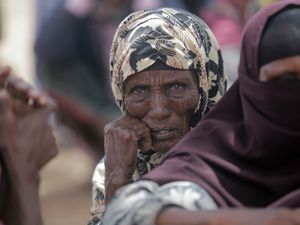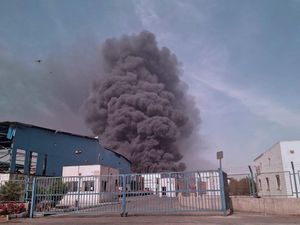US buying large shipment of Ukrainian grain for food aid
It will be taken to parts of the world enduring drought and hunger.

The United States is to buy about 150,000 metric tons of grain from Ukraine in the next few weeks for an upcoming shipment of food aid from ports no longer blockaded by war.
The final destinations for the grain are not confirmed and discussions continue, World Food Programme (WFP) chief David Beasley said.
But the planned shipment, one of several the UN agency is pursuing, is more than six times the amount of grain that the first WFP-arranged ship from Ukraine is now carrying towards people in the Horn of Africa at risk of starvation.
Mr Beasley was speaking from northern Kenya, which is deep in a drought that is withering the region. He sat under a thorn tree among local women who said it last rained in 2019.

Their bone-dry communities face yet another failed rainy season within weeks that could tip parts of the region, especially neighbouring Somalia, into famine.
Already, thousands of people have died. The World Food Programme says 22 million people are hungry.
Mr Beasley said “there’s a high probability we’ll have a declaration of famine” in the coming weeks.
He called the situation facing the Horn of Africa a “perfect storm on top of a perfect storm, a tsunami on top of a tsunami”, as the drought-prone region struggles to cope amid high food and fuel prices driven partly by the war in Ukraine.

The keenly awaited first aid ship from Ukraine is carrying 23,000 metric tons of grain, enough to feed 1.5 million people on full rations for a month, Mr Beasley said.
It is expected to dock in Djibouti on August 26 or 27, and the wheat is supposed to be shipped overland to northern Ethiopia, where millions of people in the Tigray, Afar and Amhara regions have faced not only drought but deadly conflict.
Ukraine was the source of half the grain that WFP bought last year to feed 130 million hungry people. Russia and Ukraine signed agreements with the UN and the Turkish government last month to enable exports of Ukrainian grain for the first time since Russia’s invasion in February.
But the slow reopening of Ukraine’s ports and the cautious movement of cargo ships across the mined Black Sea will not solve the global food security crisis, Mr Beasley said. He warned that richer countries must do much more to keep grain and other assistance flowing to the hungriest parts of the world, and he named names.
“With oil profits being so high right now – record-breaking profits, billions of dollars every week – the Gulf states need to help, need to step up and do it now,” he said.

“It’s inexcusable not to. Particularly since these are their neighbours, these are their brothers, their family.”
He asserted the World Food Programme could save “millions of lives” with just one day of Gulf countries’ oil profits.
China needs to help as well, he added.
“China’s the second-largest economy in the world, and we get diddly-squat from China,” or very little, he added.
Despite grain leaving Ukraine and hopes rising of global markets beginning to stabilise, the world’s most vulnerable people face a long, difficult recovery, the WFP chief said.
“Even if this drought ends, we’re talking about a global food crisis at least for another 12 months.
“But in terms of the poorest of the poor, it’s gonna take several years to come out of this.”





